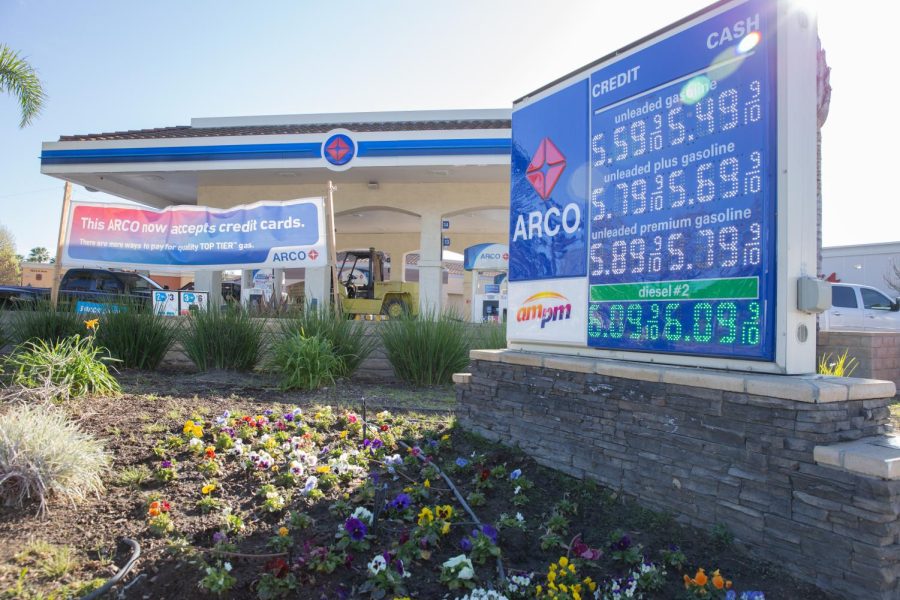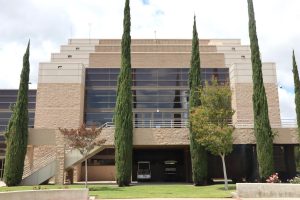Moorpark College students and faculty share views on rising inflation rates
Gasoline prices displayed at the Arco gas station on the corner of Los Angeles Avenue and Moorpark road, on Monday, March 14, 2022, in Moorpark, CA. Photo credit: Christopher Schmider
April 21, 2022
Inflation rates have been on the rise in the United States. This has had a big impact on the country’s student population.
Since the start of the COVID-19 pandemic, inflation rates have been on a steady rise. The annual inflation rate in 2019 was 1.8%, but the rate jumped significantly to 7% in 2021.
On Feb. 10, the U.S. Department of Labor stated that the annual inflation rates have hit 7.5%, the highest it has been in over forty years. Housing, food, entertainment, essentials, school supplies and gas prices have all risen in the last twelve months, putting a financial burden on students.
The rise in inflation rates is due to factors such as the pandemic. Labor shortages caused by the pandemic as well as higher demands for certain products have also contributed to the increase in inflation.
The effects of rising inflation rates are noticeable and people are being vocal about the causes and impacts of inflation. When asked about what they believed to be the cause of the concerning hike in inflation, Moorpark College students blamed the pandemic.
Kayenat Barak, president of Moorpark College’s Future Business Leaders of America club, stated that the recent rise is due to the COVID-19 pandemic.
“It’s unfortunate, but it has come due to Covid and everyone panicking due to trying to accumulate resources for their health,” stated Barak.
Alyssa Brook, a first-year student at Moorpark College mentioned how the raising of gas prices was inevitable considering all the lost funding that needed to be made up for due to the pandemic.
“I feel like the pandemic has drastically affected the raising prices,” stated Brook. “No one was driving anywhere. No one was shopping.”
Moorpark College’s faculty members also commented on the rising inflation rates.
Rena Petrello, professor of Mathematical Reasoning for Liberal Arts, shared many of the same views stated previously, stating that it wasn’t just the United States’ economy affected by raising inflation rates but the world’s as well.
“Because of Covid, our economy has been hit and it’s not just the United States’ economy but the world’s economy,” stated Petrello.
Inflation is on the rise throughout the world. According to Eurostat, annual inflation was up to 5.1% in the Euro area and 5.6% in the European Union. In South Korea, consumer inflation increased to 2.5% in 2021. Australia’s inflation rate went from 3% percent in 2021 to 3.5% in 2022.
Petrello also asserted that businesses are raising prices to make up for losses caused by the COVID-19 pandemic.
“We have seen businesses shut down, people have been out of work. Businesses are driving up the cost of their goods, largely to make up for the losses during Covid time,” stated Petrello.
While it may seem that inflation rates are going to continue rising, there are policies and actions the government can implement to prevent such an economic catastrophe.
Contractionary monetary policy can be used to help slow inflation. This monetary policy includes increasing short-term interest rates, raising the reserve requirements and expanding open market operations.
Increasing short-term interest rates slows down the economy by discouraging people from borrowing money. Raising the reserve requirements limits the amount of money a bank can loan out.
Expanding open market operations prevents people from getting loans and investing money. The aforementioned solutions will decrease the money supply in the economy and are expected to help combat inflation.
In order to try to halt the increase in inflation, the federal government announced plans on Feb. 23 to increase interest rates.







